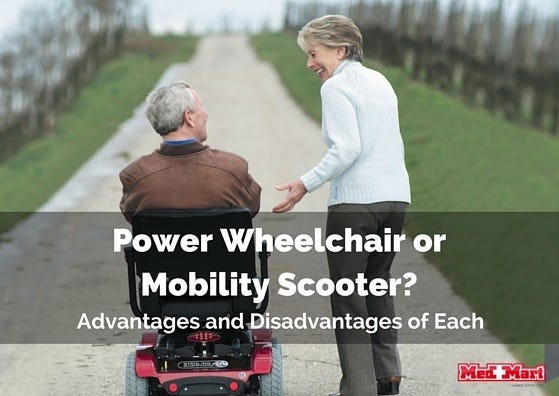If you’re hampered by joint pain, muscle weakness or just can’t stay on your feet as long as you used to, there’s no reason to restrict your activities, especially with today’s technology. Power wheelchairs and mobility scooters can enable you to become more active, independent and involved.
In fact, these devices have become so popular that the mobility aid business has evolved into a major industry, with hundreds of models to choose from. That’s where things can get a little confusing. Sometimes it’s difficult to determine what device and model to choose.
Wheelchairs and scooters each have distinct advantages and disadvantages, and within each category, there are reasons why one model might suit an individual better than another. Plus, everyone is a little different, with different types of surroundings and circumstances.
In order to help you make the best choice, we’ll discuss the characteristics of each device.
Advantages of motor scooters
Motor scooters are built for outdoor use and longer distances. This provides more independence because you don’t need to ask for a ride to attend an event or go shopping a couple of miles away. You can just hop into your scooter and go where you want.
Most scooters have a simple design, which means they often cost less and repairs are not as expensive. In addition, modern mobility scooters don’t look like wheelchairs. They have a cool, sleek look and can travel faster than wheelchairs. Some scooters can get up to 10 mph.
And they’re more transportable. You don’t need special lifts or transport vehicles to move them. Compact scooters can be folded up, placed in the trunk or back seat of a car, or put into a small trailer.
Disadvantages of motor scooters
Scooters are a little harder to navigate, especially for people who lack upper-body mobility and strength. They have a steering wheel that requires outstretched arms while wheelchairs use a joystick.
If you need help standing up or have posture issues, a motor scooter doesn’t offer as much support as a wheelchair. It’s not as comfortable as a wheelchair, either, so if you need to spend a good part of your day in a scooter, that could be an issue.
Advantages of powered wheelchairs
One of the major selling points of an
electric wheelchair is its indoor navigation. The shorter base gives it a tighter turn radius that makes maneuvering much easier, especially in close quarters like doctor’s offices, people’s homes, stores and restaurants.
Wheelchairs can also be used outdoors, making them a versatile option. One of the other important features is advanced seat adjustment capabilities, which adds comfort, enables you to recline and aids in the transition to standing.
Because of their adjustable design, wheelchairs are excellent for long-term use. You can modify and fine-tune the device to suit your needs as you get older. In addition, wheelchairs are more suitable for public transportation since local regulations mandate that buses, trains and subways provide easy access and space for them.
Disadvantages of powered wheelchairs
Electric wheelchairs are very heavy and not particularly portable. A specially-designed wheelchair lift is needed to place them in a vehicle; a scooter lift, in most cases, can’t handle the additional weight. In some instances, however, a powered wheelchair can be transported in a vehicle with open spacing. The wheels can be locked and the individual can sit in the seat.
Med Mart (
medmartonline.com) carries a wide array of high-quality mobility scooters and powered wheelchairs. To find the model that best suits your needs, call us at 800-950-4400 or send an email to
customercare@medmartonline.com. One of our representatives will be happy to discuss any concerns you might have and help you find the best model for your situation.
